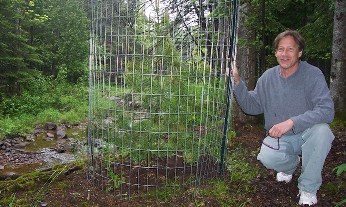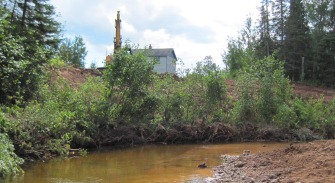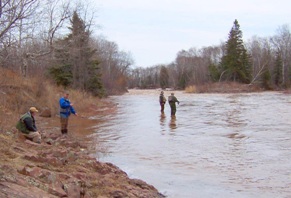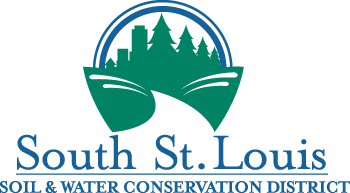Knife wins big grant to address steep problems
Winter, 2015
Our office is currently assisting the Lake Superior Steelhead Association with a geomorphic assessment of the Main West Branch and Stanley Creek in the Knife River Watershed. This work will help prioritize which reaches should be restored first, and what sort of restoration activities would be more appropriate and beneficial for each reach.
In November, 2012, the Great Lakes Commission awarded $293,000 to Lake County SWCD and partners (including us) for sediment reduction projects. This grant is one of only a handful awarded throughout the eight states constituting the Great Lakes basin membership.
Having documented that the Knife exceeds its turbidity goal by 90% during flood events, this grant money enables partner agencies to do a few large streambank restoration projects. The Knife is the highest priority watershed for turbidity reduction along Minnesota’s Lake Superior Shore.
The goal is to reduce sediment loads by 750 tons per year. That’s 21 percent of the estimated total sediment load.
One site with a collaborating landowner has already been selected and studied. This shovel-ready project will be undertaken in Phase I of the three-year grant period. During Phase II, other eligible sites will be identified and prioritized, according to geologic need and landowner willingness. The bulk of the grant funds will be spent during Phase III, when all projects are implemented.
Congratulations to Lake County SWCD, and to Lake County Forestry Dept., St Louis County Land Dept., Minnesota Pollution Control Agency, the Board of Soil and Water Resources, Minnesota Dept. of Natural Resources, and us, South St Louis SWCD!
And congratulations to you, who fish, hike, reside, retire, and recreate within the Knife River watershed and the Great Lakes basin. Now back to work.
Learn more about the Great Lakes Commission and its unique, state/province coordination of programs.
Additional Information
Knife River Technical Studies & Plans
Knife River Implementation Plan (pdf)
Map of Knife River Watershed
Knife River TMDL Plan
Knife River Sediment Reduction Grant
Knife River Sediment Reduction-2010 Clean Water Fund-Final Report
Knife River Fund Interim Report – May 2011
Knife River Match Report – May 2011
Knife R. Progress Report – Feb. 2011
Overview Fact Sheet from MN Board of Water Resources (pdf)
Edge of the Knife
Fall 2011 newsletter
Conservation planting
In 2011, over 15 landowners received free trees and tree planting from our office and the MN Conservation Corps, thanks to our Clean Water Fund Grant for reducing peak flows and sedimentation in the Knife River.
At left, Ron Benson crouches beside a newly planted white pine, caged to protect it from browsing deer.
We interviewed three landowners and photographed their newly planted sections of the Knife and its tributaries. View the article and photos, “Tree planting project reveals the many faces of the Knife River.”

Toe-wood erosion control project shows effective alternative to riprap
In 2011, part of our Clean Water Fund grant went to reclaiming an eroded riverbank along the Knife. The project uses all organic materials—tree trunks, root wads, brush, clay, fine soil, and sod mats of willow, dogwood and alder—placed in three days with the help of some heavy equipment. View great action photos on our Facebook page.
Also, see after the flood photos showing how the toe-wood project held its ground in the 2012 Flood.
To see an illustration of how this project was constructed, view the Rosgen Toe Wood Burrito.

Join Advocates for the Knife River Watershed
The Knife River has a citizens’ group, which anyone with property in the watershed can join. Advocates for the Knife River Watershed meets monthly. With help from Minnesota Environmental Partnership (MEP), it will incorporate as a nonprofit. If you would like to be involved, email MEP’s Andrew Slade or call him at (218) 727-0800.
Many agencies and individuals work for Knife River’s ecological health
A Stewardship Committee brings the best minds and experience to bear, including members from:
- Izaak Walton League
- Lake County Forestry Department
- Lake County Soil & Water Conservation District
- Lake Superior Steelhead Association
- MN Board of Water and Soil Resources
- MN DNR Fisheries, Forestry, and Wildlife
- Minnesota Environmental Partnership
- MN Pollution Control Agency
- Natural Resources Research Institute
- Saint Louis County Land Department
- South St. Louis Soil & Water Conservation District
- Trout Unlimited
- University of Minnesota Extension
Knife River Total Maximum Daily Load (TMDL)
Listed: 1998
Impairment: Turbidity
Current Status: TMDL study completed and accepted by EPA June of 2010.
FINAL Implementation Plan was approved by MPCA December of 2011.


